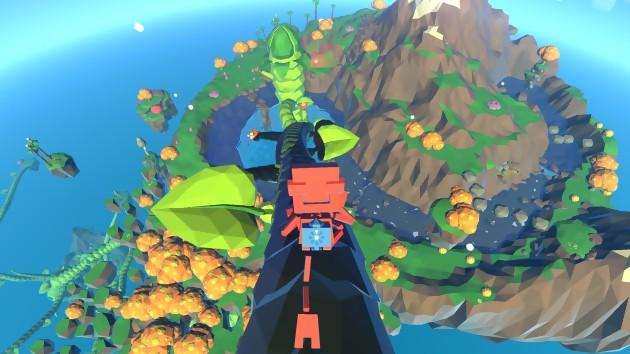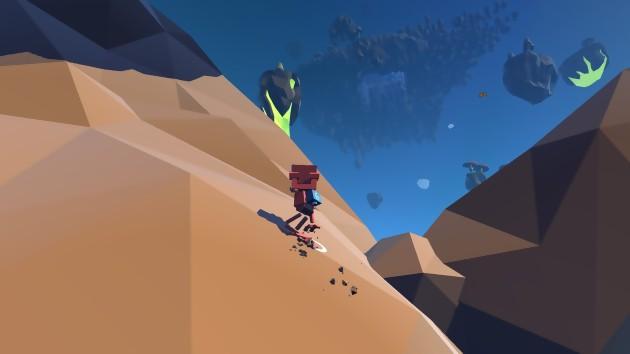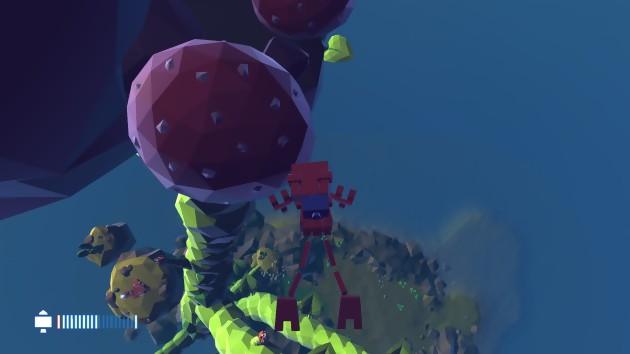 Parachuted onto a planet hosting a Star Plant, the BUD robot is in charge of making said plant climb to the skies. And… that's about it for the scenario, deliberately minimalist and quickly dispatched in the first seconds of the game. Thereafter, Grow Home focuses mainly on its gameplay, which gives pride of place to exploration and leaves no lack of freedom for the player. In bad shape following his fall, our Botanical Utility Droid quickly regains the ability to jump by absorbing a crystal planted in the background. He can absorb up to 100, in order to unlock new abilities at different levels. Finding 10 crystals allows for example to unlock a very remote view, thanks to which it will be easier to find the remaining resources. Collecting 20 gives access to a jet pack, whose thrust and duration will be increased by absorbing 40 then 60 precious pebbles. The most patient players and the most collectors will be rewarded with an unlimited duration jetpack once all the crystals have been found. But it is possible to complete the game without even worrying about these harvests, because our robotic hero is a climbing specialist. With a left trigger right trigger (or left click right click if using a mouse), you can climb almost anywhere. One hand is enough to cling to the walls, and you have to find the right rhythm to progress in the most fluid way possible. The sensations are very good, we take a real pleasure in tackling the most vertical surfaces. Beyond the rock climbing, the general animation of the robot is delightful. Procedural (i.e., basically, real-time, not pre-programmed) animation techniques and physics management ensure smooth and consistent movements and interactions with the environment. The sometimes awkward approach of the robot even contributes to the pleasure of the game, its iconoclastic aspect being enhanced by very nice electronic sound effects.
Parachuted onto a planet hosting a Star Plant, the BUD robot is in charge of making said plant climb to the skies. And… that's about it for the scenario, deliberately minimalist and quickly dispatched in the first seconds of the game. Thereafter, Grow Home focuses mainly on its gameplay, which gives pride of place to exploration and leaves no lack of freedom for the player. In bad shape following his fall, our Botanical Utility Droid quickly regains the ability to jump by absorbing a crystal planted in the background. He can absorb up to 100, in order to unlock new abilities at different levels. Finding 10 crystals allows for example to unlock a very remote view, thanks to which it will be easier to find the remaining resources. Collecting 20 gives access to a jet pack, whose thrust and duration will be increased by absorbing 40 then 60 precious pebbles. The most patient players and the most collectors will be rewarded with an unlimited duration jetpack once all the crystals have been found. But it is possible to complete the game without even worrying about these harvests, because our robotic hero is a climbing specialist. With a left trigger right trigger (or left click right click if using a mouse), you can climb almost anywhere. One hand is enough to cling to the walls, and you have to find the right rhythm to progress in the most fluid way possible. The sensations are very good, we take a real pleasure in tackling the most vertical surfaces. Beyond the rock climbing, the general animation of the robot is delightful. Procedural (i.e., basically, real-time, not pre-programmed) animation techniques and physics management ensure smooth and consistent movements and interactions with the environment. The sometimes awkward approach of the robot even contributes to the pleasure of the game, its iconoclastic aspect being enhanced by very nice electronic sound effects.
FRIEND BUD
 Close to a platform game and based on exploration, the gameplay is enriched by the presence of some plant aids. Picking up flowers allows us to temporarily deploy a parachute, while some leaves allow us to hang glide for a few seconds. Even more punctually, the Star Plant's leaves propel BUD into the air when he jumps on them. All this is very useful for reaching the different shoots present on this modern-day magic bean. Then all you have to do is hold on to the buds, press the action button and take control for a few moments of the shoot in extension, which you must quickly hang on to one of the rocks floats present in the decor. This is how the Star Plant draws the energy necessary for its growth. Little by little, the player creates a veritable plant sculpture, and reaches ever higher heights, teleporters scattered in the decor allowing him not to have to climb everything again in the event of a bad fall. In any case, the pleasure of discovery is permanent and the view of the improbable landscapes is always delightful.
Close to a platform game and based on exploration, the gameplay is enriched by the presence of some plant aids. Picking up flowers allows us to temporarily deploy a parachute, while some leaves allow us to hang glide for a few seconds. Even more punctually, the Star Plant's leaves propel BUD into the air when he jumps on them. All this is very useful for reaching the different shoots present on this modern-day magic bean. Then all you have to do is hold on to the buds, press the action button and take control for a few moments of the shoot in extension, which you must quickly hang on to one of the rocks floats present in the decor. This is how the Star Plant draws the energy necessary for its growth. Little by little, the player creates a veritable plant sculpture, and reaches ever higher heights, teleporters scattered in the decor allowing him not to have to climb everything again in the event of a bad fall. In any case, the pleasure of discovery is permanent and the view of the improbable landscapes is always delightful.
Made of rough-hewn polygons, the graphics are more or less reminiscent of those of the strategy game Darwinia and exude a certain charm, which helps to make Grow Home a game apart.
 Sometimes, we forget the objective and we even surprise ourselves to observe or visit this vertical world just for fun, which shelters hidden caves, floating islands, mountains, lakes, a lot of plants and some animals. Made of rough-hewn polygons, the graphics are more or less reminiscent of those of the strategy game Darwinia and exude a certain charm, which helps to make Grow Home a game apart. Difficult to fault, the latest from Ubisoft, however, has a soundtrack that is a little too discreet, and can be finished in less than two hours if you abandon the hunt for crystals and just go directly grow the plant. But it's hard to see which player would deprive himself of a few extra hours of fun, as it is so pleasant to explore the vegetal and polygonal world of Grow Home!
Sometimes, we forget the objective and we even surprise ourselves to observe or visit this vertical world just for fun, which shelters hidden caves, floating islands, mountains, lakes, a lot of plants and some animals. Made of rough-hewn polygons, the graphics are more or less reminiscent of those of the strategy game Darwinia and exude a certain charm, which helps to make Grow Home a game apart. Difficult to fault, the latest from Ubisoft, however, has a soundtrack that is a little too discreet, and can be finished in less than two hours if you abandon the hunt for crystals and just go directly grow the plant. But it's hard to see which player would deprive himself of a few extra hours of fun, as it is so pleasant to explore the vegetal and polygonal world of Grow Home!


























